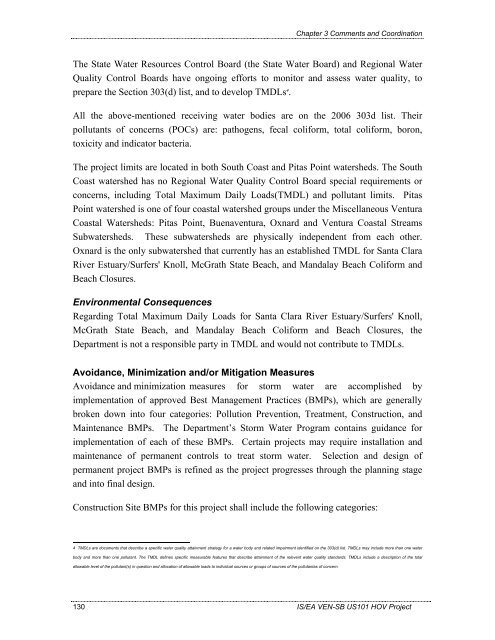Chapter 1 - Caltrans - State of California
Chapter 1 - Caltrans - State of California
Chapter 1 - Caltrans - State of California
You also want an ePaper? Increase the reach of your titles
YUMPU automatically turns print PDFs into web optimized ePapers that Google loves.
<strong>Chapter</strong> 3 Comments and Coordination<br />
The <strong>State</strong> Water Resources Control Board (the <strong>State</strong> Water Board) and Regional Water<br />
Quality Control Boards have ongoing efforts to monitor and assess water quality, to<br />
prepare the Section 303(d) list, and to develop TMDLs 4 .<br />
All the above-mentioned receiving water bodies are on the 2006 303d list. Their<br />
pollutants <strong>of</strong> concerns (POCs) are: pathogens, fecal coliform, total coliform, boron,<br />
toxicity and indicator bacteria.<br />
The project limits are located in both South Coast and Pitas Point watersheds. The South<br />
Coast watershed has no Regional Water Quality Control Board special requirements or<br />
concerns, including Total Maximum Daily Loads(TMDL) and pollutant limits. Pitas<br />
Point watershed is one <strong>of</strong> four coastal watershed groups under the Miscellaneous Ventura<br />
Coastal Watersheds: Pitas Point, Buenaventura, Oxnard and Ventura Coastal Streams<br />
Subwatersheds. These subwatersheds are physically independent from each other.<br />
Oxnard is the only subwatershed that currently has an established TMDL for Santa Clara<br />
River Estuary/Surfers' Knoll, McGrath <strong>State</strong> Beach, and Mandalay Beach Coliform and<br />
Beach Closures.<br />
Environmental Consequences<br />
Regarding Total Maximum Daily Loads for Santa Clara River Estuary/Surfers' Knoll,<br />
McGrath <strong>State</strong> Beach, and Mandalay Beach Coliform and Beach Closures, the<br />
Department is not a responsible party in TMDL and would not contribute to TMDLs.<br />
Avoidance, Minimization and/or Mitigation Measures<br />
Avoidance and minimization measures for storm water are accomplished by<br />
implementation <strong>of</strong> approved Best Management Practices (BMPs), which are generally<br />
broken down into four categories: Pollution Prevention, Treatment, Construction, and<br />
Maintenance BMPs. The Department’s Storm Water Program contains guidance for<br />
implementation <strong>of</strong> each <strong>of</strong> these BMPs. Certain projects may require installation and<br />
maintenance <strong>of</strong> permanent controls to treat storm water. Selection and design <strong>of</strong><br />
permanent project BMPs is refined as the project progresses through the planning stage<br />
and into final design.<br />
Construction Site BMPs for this project shall include the following categories:<br />
4 TMDLs are documents that describe a specific water quality attainment strategy for a water body and related impairment identified on the 303(d) list. TMDLs may include more than one water<br />
body and more than one pollutant. The TMDL defines specific measurable features that describe attainment <strong>of</strong> the relevent water quality standards. TMDLs include a description <strong>of</strong> the total<br />
allowable level <strong>of</strong> the pollutant(s) in question and allocation <strong>of</strong> allowable loads to individual sources or groups <strong>of</strong> sources <strong>of</strong> the pollutantas <strong>of</strong> concern.<br />
130 IS/EA VEN-SB US101 HOV Project

















